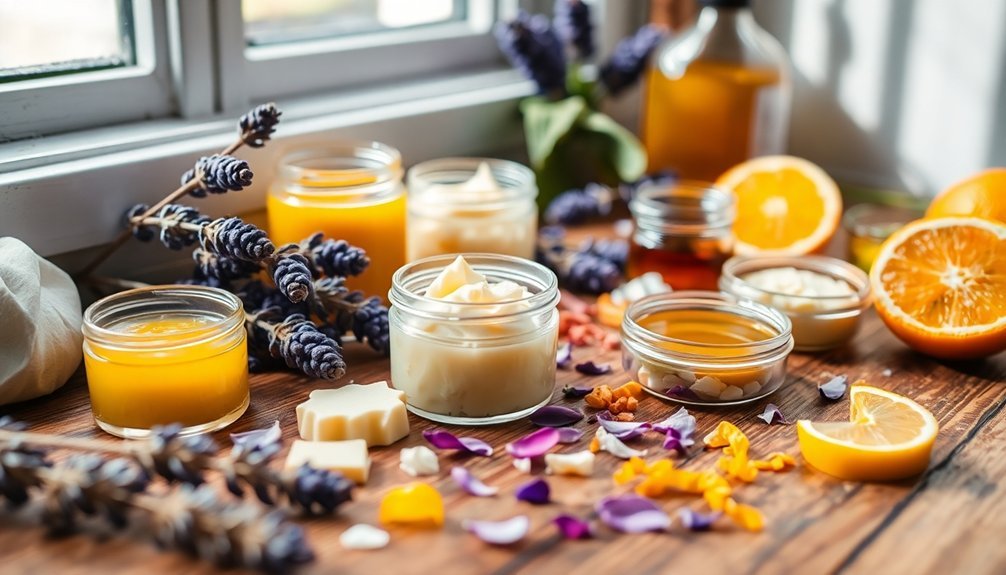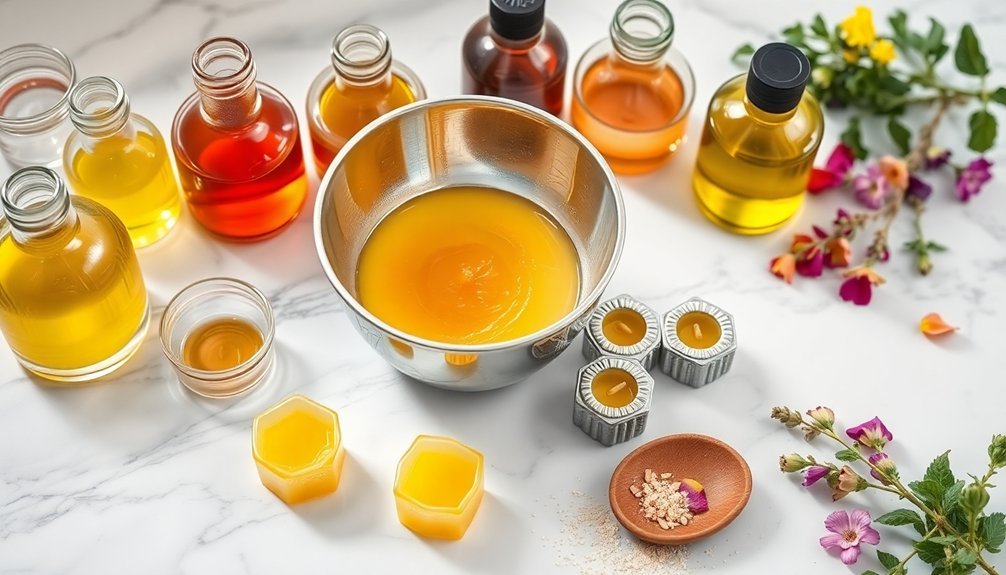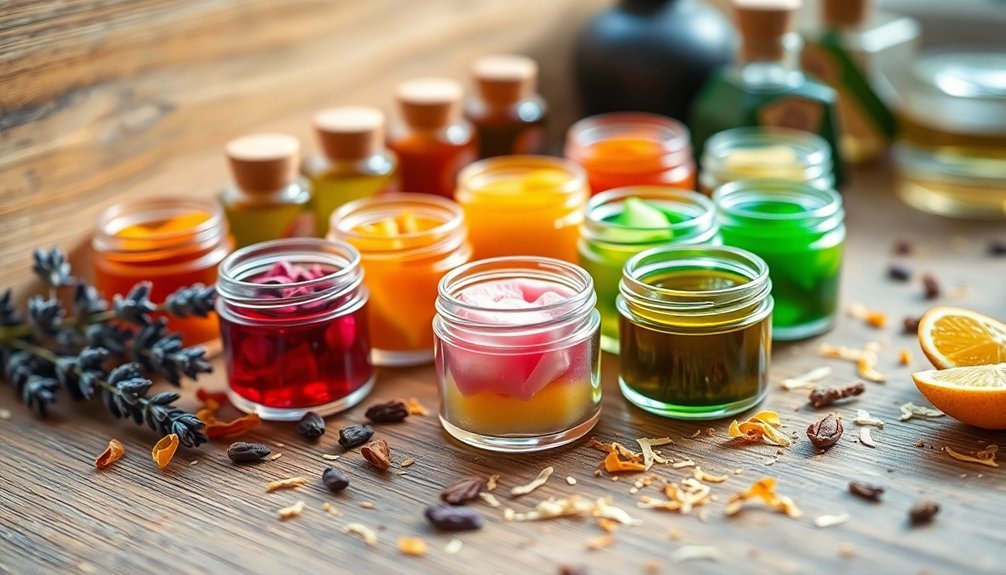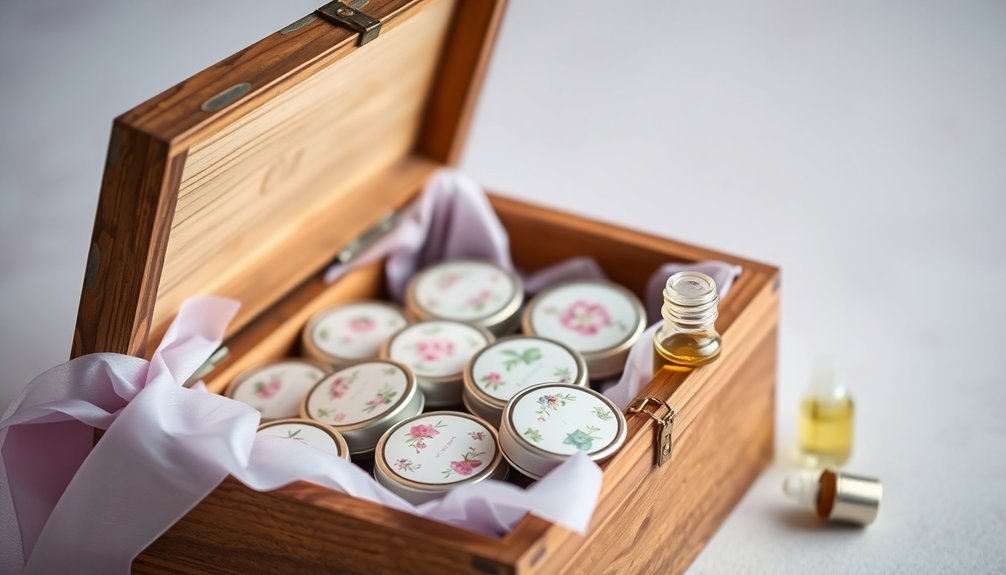Craft your own pocket-sized solid perfume bars by combining equal parts beeswax and carrier oil (like jojoba or fractionated coconut oil) with your favorite essential oils. You'll need about 2 tablespoons each of wax and oil, plus 10-15 drops of fragrance per batch. Melt ingredients using a double boiler, pour into small containers, and let solidify. For the perfect consistency and long-lasting scent, understanding the right ratios and mixing techniques makes all the difference.
Understanding the Magic of Solid Perfume Bars

Solid perfume bars represent a perfect blend of artistry and practicality in personal fragrance. You'll find these pocket-sized wonders are crafted from a harmonious mixture of beeswax and carrier oils, creating a texture similar to your favorite lip balm. The recommended ratio is equal parts beeswax and carrier oil for the perfect consistency.
What makes these bars truly special is their versatility. You can customize your scent by combining different essential oils or skin-safe fragrances, achieving your signature aroma.
With a recommended fragrance load of 9-15%, you'll get the perfect scent intensity that lasts for hours. The natural ingredients, including sweet almond or coconut oil as carriers, are gentler on your skin than traditional alcohol-based perfumes.
Nature's gentleness meets lasting fragrance in solid perfumes, where essential oils blend with nourishing carriers for a kinder approach to personal scent.
Plus, you can package your creation in various containers, from vintage lockets to sleek tins, making them both practical and stylish.
Essential Tools and Materials for Your Perfume Bar
You'll need a well-organized workspace with essential tools like glass beakers, digital scales, and protective gear to create your solid perfumes safely and precisely.
Keep your materials stored in airtight containers and clearly label everything, from your essential oils to your finished products, using a consistent system that works for you.
Your setup should include dedicated areas for measuring, mixing, and storing both ingredients and tools, with easy access to frequently used items like pipettes and stirring rods.
Always keep a detailed record-keeping system nearby to document your formulations, blending ratios, and observations during the creative process.
Basic Equipment Setup Tips
Creating your own solid perfumes begins with assembling the right set of tools and materials for your perfume bar.
You'll need fragrance blotters to test scent strengths, digital scales for precise measurements, and glass beakers for mixing ingredients. Don't forget protective gear like gloves and safety glasses to guarantee safe handling.
For melting and mixing, you'll want a reliable heat source, such as a double boiler or microwave, along with ceramic or glass bowls that can withstand heat. Consider having rubber-sealed containers ready for storing your finished perfumes.
Keep glass stirring rods and metal spatulas handy for mixing ingredients thoroughly. Essential tools for precise measurements include pipettes and droppers for your oils, and measuring spoons for solid ingredients like beeswax.
Having these basic tools ready will help you create consistent, high-quality solid perfumes.
Storage Solutions That Work
A well-organized perfume-making workspace starts with smart storage solutions.
You'll need airtight containers to protect your essential oils' potency and fragrance. Store these in cool, dark spaces to prevent degradation from light and heat exposure.
Consider installing wooden or metal shelving to keep your supplies easily accessible. You can maximize space by using corner organizers for your ingredients and tools.
For smaller items like pipettes and measuring cups, drawer dividers work perfectly to maintain order and prevent clutter.
Don't forget to organize your beeswax, carrier oils, and vitamin E separately from your essential oils.
If you're using pigments, keep them in sealed containers away from other ingredients.
Your tools, including heat-resistant bowls and protective gear, should have their designated spots for quick access during creation.
Selecting the Perfect Base Ingredients

Three essential base components form the foundation of any successful solid perfume: carrier oils, natural waxes, and fragrant oils.
You'll want to start with jojoba or fractionated coconut oil as your carrier, since they won't compete with your chosen scents. For the wax component, beeswax offers ideal stability, while candelilla wax serves as an excellent vegan alternative.
When selecting your fragrant oils, consider building a three-tiered scent profile:
- Top notes like citrus or lemongrass for immediate impact
- Middle notes such as lavender or geranium for the heart of your fragrance
- Base notes including sandalwood or vanilla for lasting power
Mix these components carefully, using a double boiler to prevent burning, and you'll create the perfect solid perfume base.
Crafting Signature Scent Combinations
Building your own signature scent starts with understanding how different fragrances interact and complement each other. Essential oils and fragrance oils form the foundation, with top notes providing immediate impact, middle notes offering sustained presence, and base notes delivering lasting depth.
You'll find endless possibilities for unique combinations. Try pairing sweet orange with lemon and grapefruit for a bright citrus blend, or mix lavender, rosemary, and mint for a revitalizing herbal aroma.
For complex scents, layer different notes strategically – bergamot's crisp top note works beautifully with lavender's middle note and vanilla's rich base note.
Create romantic blends by combining rose, jasmine, and ylang-ylang, or opt for invigorating combinations like eucalyptus and peppermint.
Don't forget that grapefruit pairs wonderfully with geranium and patchouli for an intriguing balanced accord.
Step-by-Step Mixing and Pouring Process

Creating solid perfume begins with four essential steps: preparing your workspace, measuring ingredients, melting the base, and blending your chosen fragrances.
You'll need to combine equal parts beeswax and carrier oil, typically 2 tablespoons each, in a small pot over medium heat or in short microwave bursts until fully melted.
- Mix your essential oils separately to test the fragrance combination, using 10-15 drops per 2 tablespoons of base mixture.
- Pour the melted mixture carefully into prepared containers using a pipette for smaller vessels to prevent spills.
- Allow your perfume to solidify completely, and if it's too soft, simply remelt and add more beeswax to achieve the desired consistency.
Remember that your scent will continue to mature and develop over the first week after creation.
Smart Storage Solutions for Pocket Perfumes
To maximize the lifespan of your handcrafted pocket perfumes, proper storage plays an essential role in maintaining their quality and fragrance.
Store your creations in dark, dry places away from direct sunlight, preferably in their original packaging. A drawer or cupboard with stable temperature works best, but avoid bathrooms where humidity can compromise the scent.
For organization, you'll find stackable containers or mini jewelry boxes with dividers perfect for your collection.
If you're traveling, invest in TSA-compliant atomizers and waterproof pouches to prevent leaks.
Display your favorites on rotating stands or floating shelves for easy access, and organize them by scent type.
Keep track of your collection with an inventory list, and consider using decorative elements like ribbons for a personal touch.
Troubleshooting Common Perfume Bar Issues

When your solid perfume bar shows signs of uneven fragrance distribution or texture problems, you'll need to act quickly to restore its quality.
Temperature fluctuations can cause your perfume bar to become too soft or too brittle, so keeping it at room temperature and away from direct heat sources is essential.
You can fix consistency issues by gently remelting the bar and stirring thoroughly to redistribute the ingredients, ensuring a smooth and uniform texture.
Fixing Uneven Scent Distribution
Since uneven scent distribution can ruin an otherwise perfect solid perfume, knowing how to troubleshoot this common issue is crucial. The key to achieving consistent fragrance throughout your solid perfume lies in proper mixing techniques and ingredient ratios.
When you're combining your fragrance with the wax base, make sure you're stirring thoroughly and maintaining the right temperature for peak blending.
- Mix your fragrance oils with carrier oils first, then incorporate them into the melted wax slowly while stirring continuously.
- Don't exceed the recommended fragrance load for your wax type, as this can lead to separation and patchy scent distribution.
- Allow your perfume adequate time to cure and mature, which helps the fragrance bind properly with the wax base.
Temperature Control Solutions
Mastering temperature control stands at the heart of creating perfect solid perfumes. You'll need to carefully manage both heating and cooling processes to achieve the best consistency. Use a double boiler or microwave in short bursts while stirring constantly to prevent hotspots and guarantee even melting.
| Process | Do's | Don'ts |
|---|---|---|
| Melting | Use controlled heat, stir frequently | Rush the process, overheat |
| Cooling | Cool gradually, use cold water bath | Force rapid solidification |
| Storage | Keep in cool, dry place | Expose to heat or moisture |
To troubleshoot common temperature issues, adjust your wax-to-oil ratio for peak hardness. If your perfume softens too easily, increase the beeswax content and consider using containers that resist moisture. Remember to test your fragrance oils for temperature stability before combining them with your base.
Texture Consistency Problems
Creating the perfect texture in solid perfumes requires careful attention to ingredient ratios and mixing techniques. When you're experiencing texture issues, you'll need to make specific adjustments to achieve the desired consistency.
If your perfume is too soft, add more beeswax; if it's too hard, incorporate additional oils like fractionated coconut oil.
Common texture problems you might encounter include:
- Graininess from improperly melted ingredients
- Separation due to inconsistent mixing
- Rough texture from incorrect wax-to-oil ratios
To maintain the ideal consistency, use a 1.5:0.5 ratio of fragrance oil to beeswax. You can also include moisturizing additives like shea butter or coconut oil for enhanced creaminess.
Remember to conduct a spreadability test to verify your perfume applies smoothly and evenly.
Creative Packaging Ideas for Gift-Giving

When it comes to sharing your handcrafted solid perfumes, the packaging can be just as memorable as the fragrance itself. Transform upcycled mint tins into charming containers, or opt for pillow boxes that add a delightful touch to travel-sized creations.
You'll find that die-cut boxes with unique shapes can make your gifts stand out, while drawer-style packaging offers an elegant presentation.
Consider adding personal elements like ribbons and charms for a DIY touch that recipients will love. For an eco-conscious approach, choose kraft materials with natural patterns, following Le Labo's minimalist style.
Small personal touches and sustainable materials create thoughtful packaging that makes your handcrafted perfumes truly special and gift-worthy.
If you're crafting for special occasions, themed packaging with embossed textures can elevate your gift. Don't forget to incorporate social media-friendly designs that'll encourage sharing and showcase your creative presentation.
Frequently Asked Questions
Can Solid Perfumes Trigger Airport Security Alarms During Travel?
You won't trigger airport security alarms with solid perfumes. They're safe for travel and don't need special screening. Unlike liquids, you can keep them in your bag during security checks without concern.
How Long Does Homemade Solid Perfume Remain Fresh Before Expiring?
Your homemade solid perfume will stay fresh for 6-12 months when you store it in a cool, dry place. You'll get the best results by keeping it in an airtight container away from heat and moisture.
Will Solid Perfume Stain Clothes When Applied Directly?
Yes, your solid perfume can stain clothes if applied directly. It's best to apply it to your skin and let it absorb before dressing. The oils in the formula may leave marks on fabric.
Can I Melt and Reform Solid Perfume if It Becomes Too Soft?
Yes, you can remelt and reform your soft solid perfume. Just heat it gently, add more beeswax to increase firmness, then let it cool slowly. Store it in an airtight container afterward.
Do Weather Conditions Affect the Performance of Solid Perfumes?
Yes, weather dramatically affects your solid perfume's performance. You'll notice it lasts longer in cool temperatures but may soften in heat. High humidity can enhance longevity, while dry conditions may weaken the scent projection.





Leave a Reply